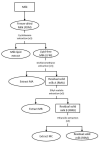A Mechanistic Study of the Antiaging Effect of Raw-Milk Cheese Extracts
- PMID: 33802038
- PMCID: PMC8000626
- DOI: 10.3390/nu13030897
A Mechanistic Study of the Antiaging Effect of Raw-Milk Cheese Extracts
Abstract
Many studies have highlighted the relationship between food and health status, with the aim of improving both disease prevention and life expectancy. Among the different food groups, fermented foods a have huge microbial biodiversity, making them an interesting source of metabolites that could exhibit health benefits. Our previous study highlighted the capacity of raw goat milk cheese, and some of the extracts recovered by the means of chemical fractionation, to increase the longevity of the nematode Caenorhabditis elegans. In this article, we pursued the investigation with a view toward understanding the biological mechanisms involved in this phenomenon. Using mutant nematode strains, we evaluated the implication of the insulin-like DAF-2/DAF-16 and the p38 MAPK pathways in the phenomenon of increased longevity and oxidative-stress resistance mechanisms. Our results demonstrated that freeze-dried raw goat milk cheese, and its extracts, induced the activation of the DAF-2/DAF-16 pathway, increasing longevity. Concerning oxidative-stress resistance, all the extracts increased the survival of the worms, but no evidence of the implication of both of the pathways was highlighted, except for the cheese-lipid extract that did seem to require both pathways to improve the survival rate. Simultaneously, the cheese-lipid extract and the dried extract W70, obtained with water, were able to reduce the reactive oxygen species (ROS) production in human leukocytes. This result is in good correlation with the results obtained with the nematode.
Keywords: Caenorhabditis elegans; DAF-16; longevity; oxidative stress; p38 MAPK; raw-milk cheese.
Conflict of interest statement
The funders (VetAgro Sup and Dômes Pharma) had no role in the design of the study; in the collection, analyses, or interpretation of data; in the writing of the manuscript; or in the decision to publish the results.
Figures












References
-
- Yasuda S., Kuwata H., Kawamoto K., Shirakawa J., Atobe S., Hoshi Y., Yamasaki M., Nishiyama K., Tachibana H., Yamada K., et al. Effect of highly lipolyzed goat cheese on HL-60 human leukemia cells: Antiproliferative activity and induction of apoptotic DNA damage. J. Dairy Sci. 2012;95:2248–2260. doi: 10.3168/jds.2011-4153. - DOI - PubMed
-
- Cardin G., Ripoche I., Poupet C., Bonnet M., Veisseire P., Chalard P., Chauder A., Saunier E., Priam J., Bornes S., et al. Development of an innovative methodology combining chemical fractionation and in vivo analysis to investigate the biological properties of cheese. PLoS ONE. 2020;15:e0242370. doi: 10.1371/journal.pone.0242370. - DOI - PMC - PubMed
MeSH terms
Substances
Grants and funding
LinkOut - more resources
Full Text Sources
Other Literature Sources
Miscellaneous

